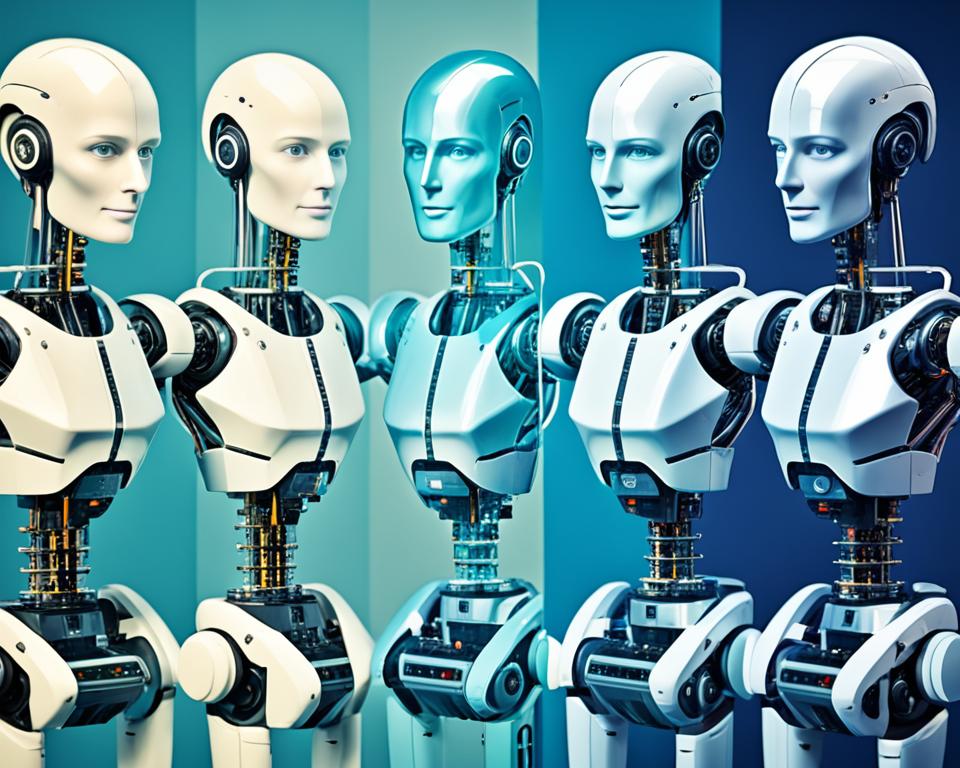Adverts
A artificial intelligence (AI) is increasingly present and is transforming the market and the future of work. A global McKinsey study estimates that AI will generate revenue of 13 trillion dollars by 2030 and drive a 5% increase in Latin America's GDP. A AI It has diverse uses, such as medical diagnosis, financial data analysis, automotive simulation, personalized retail recommendations, chatbots, and automatic language translation. Despite the debate about its pros and risks, AI has the potential to increase productivity and create new products.
Main points:
- AI is transforming the market and future of work;
- AI has significant potential to increase productivity and create new products;
- It is estimated that AI will generate trillions of dollars in revenue by 2030;
- The implementation of AI spans diverse sectors such as healthcare, finance, retail and automotive;
- It is important to consider the ethic It is governance of AI to avoid prejudices and guarantee the responsibility It is transparency in its use.
- AI is transforming the market and future of work;
- AI has significant potential to increase productivity and create new products;
- It is estimated that AI will generate trillions of dollars in revenue by 2030;
- The implementation of AI spans diverse sectors such as healthcare, finance, retail and automotive;
- It is important to consider the ethic It is governance of AI to avoid prejudices and guarantee the responsibility It is transparency in its use.
What is Artificial Intelligence?
A artificial intelligence (IA) is a field of computer Science which is dedicated to developing systems capable of performing tasks that would normally require human intelligence. AI encompasses a wide range of abilities, including learning, reasoning, problem solving, understanding natural languages, pattern recognition, and decision making. automatic decisions.
Adverts
AI systems use algorithms, which are sets of logical instructions, to simulate the human being's learning and reasoning ability. Through the machine learning, these systems can be trained with large volumes of data to identify patterns and make decisions based on those patterns.
There are different levels of artificial intelligence, from simple systems designed to perform specific tasks to more advanced and autonomous systems, capable of adapting to different scenarios. Some examples of tasks performed by AI systems include data analysis, medical diagnosis, personalized recommendations, process automation, and interactions with chatbots.
Adverts
Artificial intelligence is transforming the way we interact with technology and is driving a number of advances across a range of areas, including medicine, finance, retail and transportation. With its ability to process and analyze large volumes of data quickly and accurately, AI is making tasks possible that previously seemed unlikely. It is an area of constant study evolution, with the potential to revolutionize the future.
Algorithms and Machine Learning
You algorithms are an essential part of artificial intelligence. They are responsible for processing the data and making decisions based on this data. There are different types of algorithms used in AI, each with specific characteristics and applications.
O machine learning is a fundamental technique in AI, which allows systems to acquire knowledge and improve their performance through experience. As machine learning, AI systems can identify patterns in large data sets and use these patterns to improve their decision-making capabilities.
| Algorithms | Description |
|---|---|
| Decision tree | Model that uses a tree-shaped structure to make decisions based on different data attributes. |
| Linear Regression | Algorithm used to make numerical predictions based on historical data. |
| Neural networks | Model inspired by the functioning of the human brain, composed of interconnected units that perform complex calculations. |
These are just a few examples of algorithms used in AI. Each of them has different characteristics and is suitable for different types of problems.
See too:
Artificial intelligence is a constantly growing area and evolution, with the potential to transform the way we live and work. It is important to understand its applications and limitations, as well as the ethical and governance that arise from its use. AI is revolutionizing several sectors, opening up new possibilities and creating demand for professionals with knowledge in this area.
Evolution of Artificial Intelligence
Artificial Intelligence (AI) is not something new, but it has undergone a evolution continuous over time. The term “Artificial Intelligence” was coined in the 1950s, but the first implementations of intelligent agents began to emerge in the 1990s. Since then, significant advances have driven the field of AI, including the emergence of neural networks and the use of graphics processing units (GPU).
To the neural networks have played a fundamental role in the advancement of AI. These computational structures inspired by the functioning of the human brain allow machines to learn and recognize complex patterns. With the advent of more complex neural networks and the application of deep learning (deep learning), AI has acquired the ability to perform increasingly sophisticated and precise tasks.
Furthermore, language models such as Transformer were developed and have contributed to the development of more powerful applications of AI. Transformer, for example, revolutionized automatic language translation by introducing attention mechanisms and allowing better understanding and generation of text.
Another growing area in the evolution of AI is generative artificial intelligence. This field refers to the ability of machines to create new data and information from existing models. Using techniques such as generative adversarial models, generative AI has the potential to boost creativity and the production of innovative content.

The Use of Neural Networks in Artificial Intelligence
Neural networks have been widely used in the field of artificial intelligence due to their ability to learn and adapt. These computational structures are composed of layers of interconnected artificial neurons, which process and transmit information in a similar way to the functioning of the human nervous system.
Advances in the area of neural networks, combined with the increase in computational processing power, have allowed the development of increasingly complex and efficient models. These networks are capable of learning from data sets and recognizing patterns, making them essential in several AI applications.
| Benefits of Neural Networks in AI | Application Examples |
|---|---|
| Ability to learn and adapt | Voice recognition |
| Deal with complex, non-linear data | Computer vision |
| Identification of patterns and trends | Financial data analysis |
| Real-time information processing | Recommender systems |
With the continuous evolution of neural networks and the combination with other AI techniques, artificial intelligence will continue to advance and transform various sectors, enabling new achievements and innovative applications.
Expanding Intelligence and Collaboration between Humans and Machines
A expansion of intelligence is an approach that aims to use technology to enhance human skills. When it comes to collaboration between humans and artificial intelligence (AI), the contributions are complementary. AI offers speed, scalability, security and quantitative capabilities, while humans bring social, leadership, teamwork and creativity skills to the scene.
This collaboration is especially evident in industries like healthcare and finance, where AI is already driving significant advances. In healthcare, for example, artificial intelligence is applied in more accurate diagnoses, analysis of complex medical data and even in robot-assisted surgeries. These technologies help healthcare professionals expand their skills and provide more efficient and accurate care.
A expansion of intelligence It is also viable in back office tasks, automating routines and freeing professionals for more complex and strategic activities. With process automation, companies can achieve a significant increase in efficiency and productivity.
Collaboration between humans and machines also provides a competitive advantage for companies, enabling faster and more accurate analysis and decision-making. Furthermore, AI can help teams identify patterns and trends, enabling a more comprehensive view of the market and consumer behavior.
It is important to highlight that, despite the quantitative capabilities of AI, the human skills continue to be essential in the collaboration process. Creativity, intuition, empathy and critical thinking are intrinsically human attributes that cannot be replicated by machines.
| Human Skills | AI Contributions |
|---|---|
| Social skills | Speed |
| Leadership | Scalability |
| Team work | Security |
| Creativity | Quantitative capabilities |
“Collaboration between humans and machines allows us to take advantage of the best of both worlds, combining the human skills with the speed and efficiency of artificial intelligence.”
In short, the expansion of intelligence and collaboration between humans and machines represent a promising trend for the future of work. By recognizing and exploring the contributions of each side, it is possible to obtain exceptional results that benefit both the companies and the professionals involved.
Ethics and Governance of Artificial Intelligence
A ethic and governance of artificial intelligence are fundamental to ensuring the responsibility, transparency and avoid prejudices in the use of this technology. It is essential that programmers are aware of their actions when training an AI system, ensuring that ethical and moral values are appropriate. Furthermore, the diversity of data used in AI training is crucial to avoid the reproduction of bias and discrimination.
AI governance must consider ethical values and ensure transparent performance of the technology. Accountability mechanisms and regulations need to be created to ensure that AI is used fairly and responsibly. Transparency in the functioning of AI is important so that the decisions made by the algorithms are understood and auditable, thus avoiding opacity and possible biases.
“Artificial intelligence holds great promise, but it also brings significant ethical challenges that must be approached responsibly and carefully.” – Elon Musk
A data filtering it also plays a vital role in AI ethics and governance. The data used to train an AI system must be carefully selected and free from discriminatory bias. It is essential to ensure representativeness and impartiality in the information used so that AI can make impartial and fair decisions.
The Challenge of Biases in Artificial Intelligence
Artificial intelligence, as it is powered by data collected from society, can reflect the prejudices and discrimination present in this data. For example, a job recruitment algorithm trained on historical data may end up reproducing gender or racial biases when recommending candidates for a selection process. Therefore, awareness and care are essential to prevent the use of AI from reinforcing or widening existing inequalities.
The Importance of Transparency in Artificial Intelligence
Transparency is a fundamental issue in the governance of artificial intelligence. Understanding how AI makes decisions is essential to avoid opacity and ensure accountability. AI algorithms and models must be accessible and explainable, allowing society to understand and question the decisions they make. Clarity and openness are pillars for the responsible development and use of AI.
Image:
| ethic | Governance | Responsibility | Transparency | Prejudices | Data Filtering | |
|---|---|---|---|---|---|---|
| What is it? | Set of principles and moral values applied in the creation and use of AI. | Regulations and mechanisms to ensure the responsible and fair use of AI. | The commitment to make decisions based on ethical values and deal with the consequences of those decisions. | The functioning of AI must be clear, understandable and auditable. | The avoidance of discriminatory biases in the data used to train the AI. | The careful and impartial selection of data used in training AI systems. |
| Because it's important? | To ensure that AI is used fairly and in accordance with socially adopted values and ethical principles. | Prevent abuse, ensure accountability, and create a trusted and safe environment for using AI. | To ensure integrity and accountability in decisions made by AI systems. | Allow society to understand how AI makes decisions and question possible biases or injustices. | Avoid reproducing prejudices and discriminations present in the data used in AI training. | Ensure that the data used is impartial and representative to avoid distortions in the results. |
Conclusion
Artificial intelligence is impacting the job market significantly, automating repetitive and standardized tasks. This may reduce the demand for labor in certain areas, however, it creates a new demand for qualified professionals in areas of technological innovation. A professional retraining and training are essential to adapt to the changes brought about by artificial intelligence.
Although there are concerns about the impact of AI at the job market, it is important to remember that not all tasks can be replaced by automated systems. Human skills such as empathy, creativity and decision-making continue to be valued and are essential for a successful future of work. Collaboration between humans and machines is crucial to harnessing the benefits of artificial intelligence.
The future of work is constantly changing, and the changes brought about by artificial intelligence offer opportunities for professionals to reinvent themselves and explore new areas. A professional retraining It is essential to guarantee employability and keep up with the accelerated pace of technological evolution. If you want to stand out in this new scenario, it is important to invest in updating and acquiring market-relevant skills.
Therefore, although artificial intelligence has impact at the job market, the need for qualified professionals continues to be a reality. A professional retraining It is the key to facing the challenges and taking advantage of the opportunities that arise in this constantly evolving context.



